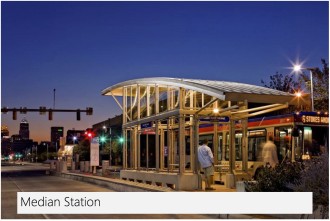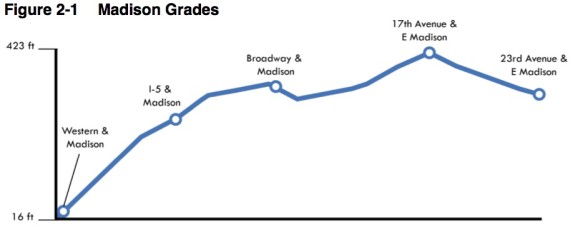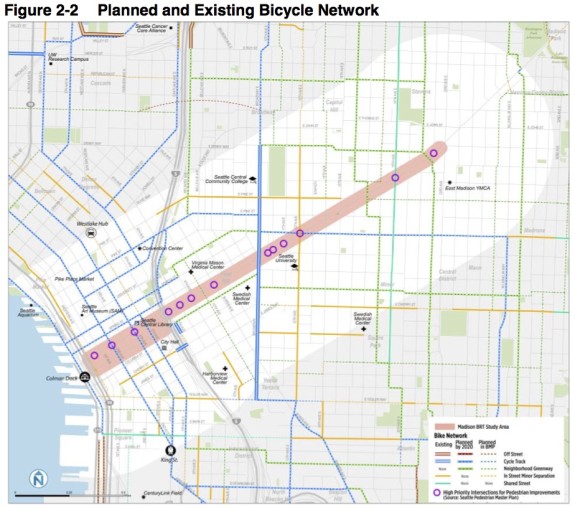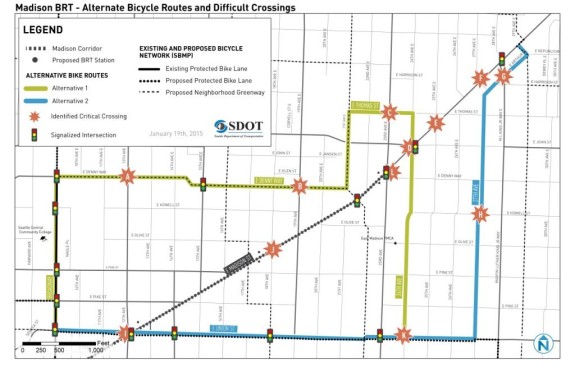
The city is currently in the outreach and design phase for a significant rapid bus project along Madison Street from the waterfront to 23rd Ave (and possibly MLK). The rapidly-developing corridor is a rare direct route diagonal to the street grid, making it a prime candidate for faster, more consistent and more reliable transit service, and it was identified in the city’s Transit Master Plan as such.
Planners are currently conducting an online survey, which you should complete by February 5.
The basic elements of a Bus Rapid Transit project along the corridor is the creation of transit-only lanes, running buses more often and having fewer-but-better stops, allowing for much faster movement even during crunch commute times. Planners are considering options that either put the bus lanes and stops in the center lanes (as pictured above) or in the curb lanes. You can learn more from this recent presentation (large PDF).
But as this is the Seattle Bike Blog, let’s look at the biking elements in the area. To meet with the city’s Complete Streets Ordinance, planners are looking for how to make sure walking and biking elements are included in the project. Especially for biking, Madison Street’s sometimes ridiculously steep grades provide some pretty significant bike route challenges. Especially downtown, Madison is so steep even a streetcar could not make the trip (thus the BRT rather than rail). If you’re on a bike, you are likely going to seek out less-steep streets nearby to get up to First Hill and beyond.
How steep is it? Here’s a graphic:
 Between the waterfront and Boylston, the average grade is 7.4 percent. The Seattle Walking Map shows seven of these 14 blocks exceed ten percent grade. To put that in perspective, blocks beyond five percent start to be a challenge for creating an all-ages and abilities bike route, though sometimes they are unavoidable in hilly Seattle.
Between the waterfront and Boylston, the average grade is 7.4 percent. The Seattle Walking Map shows seven of these 14 blocks exceed ten percent grade. To put that in perspective, blocks beyond five percent start to be a challenge for creating an all-ages and abilities bike route, though sometimes they are unavoidable in hilly Seattle.
The Seattle Bicycle Master Plan took these grade challenges into account and suggests that bike route efforts be focused on Spring and Seneca just north of Madison, where grades are still tough, but not nearly as tough as Madison:
 So Madison BRT planners have already decided that there will be no bike facility on Madison itself, and instead are looking to develop a “parallel” bike route. West of Broadway, there are some clear ways to do this: Improve the Cherry Street bike lane and its connection to Marion (which should get a neighborhood greenway facelift) and build the Seneca and/or Spring Street protected bike lanes. Either continued protected bike lanes on Seneca across First Hill would work, or maybe a University Street neighborhood greenway as noted in the Bike Master Plan.
So Madison BRT planners have already decided that there will be no bike facility on Madison itself, and instead are looking to develop a “parallel” bike route. West of Broadway, there are some clear ways to do this: Improve the Cherry Street bike lane and its connection to Marion (which should get a neighborhood greenway facelift) and build the Seneca and/or Spring Street protected bike lanes. Either continued protected bike lanes on Seneca across First Hill would work, or maybe a University Street neighborhood greenway as noted in the Bike Master Plan.
But east of Broadway, the idea of creating a route “parallel” to Madison becomes absurd because Madison is the only street that cuts a diagonal across the street grid. There simply is no parallel bike route option.
Because Madison is a diagonal street, it creates all kinds of troublesome intersections and safety issues. But it is also an extraordinary opportunity to make big strides in walking and biking safety and comfort in addition to transit reliability. In general, there need to be safe crosswalks all along the street. From a bike route perspective, here are some key intersection improvements that a Madison redesign could address:
- Union/Madison/12th: This intersection is terrible for everyone, and is dangerous for people driving, biking and walking. The Bike Master Plan calls for Union Street protected bike lanes, which would be strong candidates for inclusion as a near-Madison bike route in need of improvement. But this intersection is a big challenge. Currently, there is no way to continue directly through on Union, which poses a bike route challenge as well as a headache for Metro’s Route 2.
- Pike/14th/Madison: This crazy mess of an intersection needs a total remake. It doesn’t work for anyone, especially people on foot. But there is also a great potential bike/walk connection if people on Pike could easily and comfortably continue through the intersection. This would also be a strong connection to the old TT Minor school, which is currently the Hamlin Robinson school and should get a public school remake soon. It could also connect to the planned Pike Street protected bike lanes, and would likely become a heavily-used bike route both for getting to Capitol Hill and downtown.
- Madison/17th and Madison/16th/Pine: These intersections at the top of the hill have a ton of bike and foot traffic. The challenge for a bike route is that people need a good way to get from the Pine Street bike lanes to the top of the hill where two major grocery stores are as well as connections to a bunch of (mostly informal) neighborhood bike routes. Right now, many people bike a block or two on Madison to make this connection, but without bike lanes on Madison, there needs to be some significant improvements to provide better options. The crossing at 17th is also slated as part of a neighborhood greenway connecting along the “ridge” of the hill from Judkins Park to Volunteer Park, a crossing that could also happen at 18th with investment there.
- 22nd/21st/Denny/Madison: This area near the Safeway at the end of the BRT project is an interesting opportunity to connect the soon-to-be-constructed Central Area Neighborhood Greenway with a proposed Denny Way neighborhood greenway that would connect directly to the under-construction Capitol Hill Station light rail.
- 24th/John/Madison: This epic bottleneck even inspired the name of a great nearby bar. It is essentially impossible for people walking or biking on 24th Ave to cross the intersection legally. I couldn’t imagine doing it if I had mobility issues.

The stated bike goal of the project is to “develop a parallel bike corridor,” according to a recent open house presentation. The text of the survey puts it this way:
The Madison Corridor BRT project will advance the design of one east – west bicycle facility that generally connects the same neighborhoods as the Madison Street corridor. The bicycle facility will provide a better bike connection to the Madison corridor, while offering comfortable connections along the corridor for people of all ages and abilities. The selected route will be consistent with the Seattle Bicycle Master Plan Update adopted in 2014.
But that’s essentially impossible. If no bike lane will be provided on Madison itself, a smart collection of needed bike connections along with protected bike lanes on Union and Seneca/Spring and a neighborhood greenway on Denny is probably a more useful way of looking at the bike route needs along the corridor. At one point, the survey asks respondents to choose between Denny and Union, streets that are nearly a half mile apart. These routes serve completely different areas, so it’s impossible to choose between them. Both are needed.
Are there any other bike connections needed along this corridor? Let us know in the comments below (and, of course, complete that survey!).








Comments
8 responses to “Madison rapid bus project is chance to improve bike routes in central Seattle”
Thanks, Tom. This is a really good summary of the issues for bikes in connection with the Madison BRT. I’m afraid I’ve been so flummoxed by the discussion of a fantasy “parallel” route that I’ve been less than clear in my thinking. Just pointing out that Union and Denny serve different areas (obviously!) is helpful. Don’t you sometimes wish they’d talk this way about finding ONE east-west route for people who drive cars?
Also, I really like the suggestion of connecting the Greenway on 22nd (and the Denny east-west Greenway) with a section that crosses 23rd on Thomas and then connects to the south by way of a new bike/ped crossing of Madison at 24th. Since I live at 25th and Mercer, these are all routes that I use, but after 30+ years walking and biking in this neighborhood, I become blind to the possibilities that exist right before my eyes.
The way I see this is that it’s not necessarily important to have one bike route parallel to Madison as long as the network generally is well connected and the street doesn’t disrupt routes across it. It’s the same way I’d look at Westlake Ave in the Denny Triangle. For the BRT’s complete-streets component I’d mostly focus on intersections: making intersections work better for all the different bike and walking routes that cross Madison.
So true! it is the connections that have so much more impact than the routes. Look at all the bike lanes in this city that just vanish before difficult intersections. Make the connections work, then the routes will be easy.
I second the idea thay connections should be prioritized over route. A route suggests bicycle riders are being told where to go with the intent of providing one high-quality option. While this might make for a very nice continuous stretch what is more important is emphasizing safe connections to all nearby streets. People riding will make their own routes – as Tom hints to with the “mostly informal neighborhood bike routes.”
What Al said.
http://www.dailymail.co.uk/travel/travel_news/article-2865647/Norway-introduces-world-s-bike-escalator.html
maybe the above linked cyclo cable will help on madison
[…] is almost half a mile from Madison. At 27th and Union, the bike route is 0.7 miles from Madison. We argued previously that if a so-called “parallel” bike route is actually preferable to bike lanes on a […]